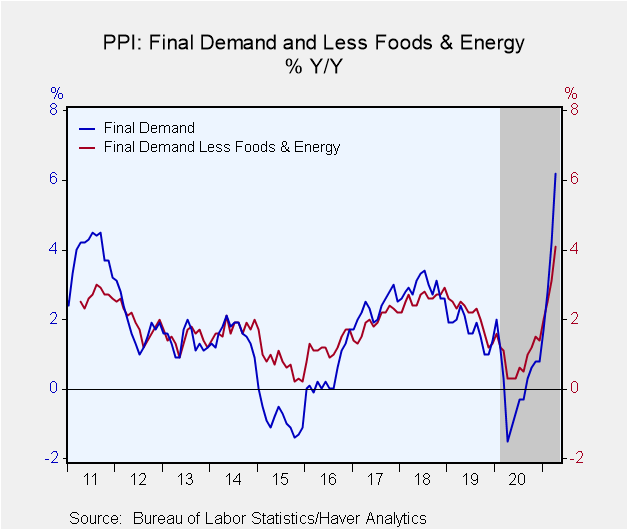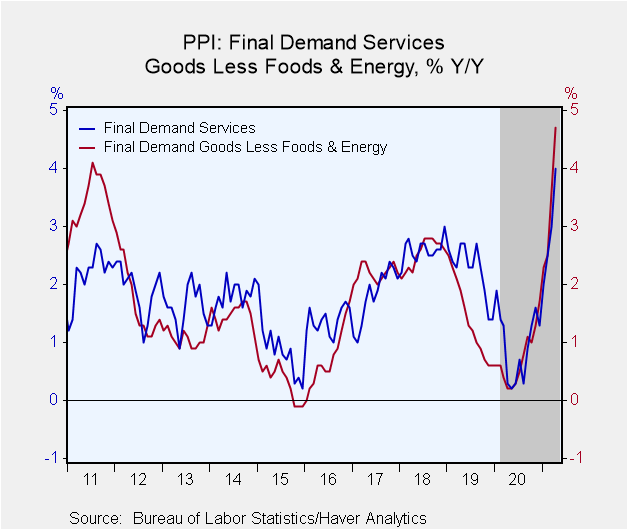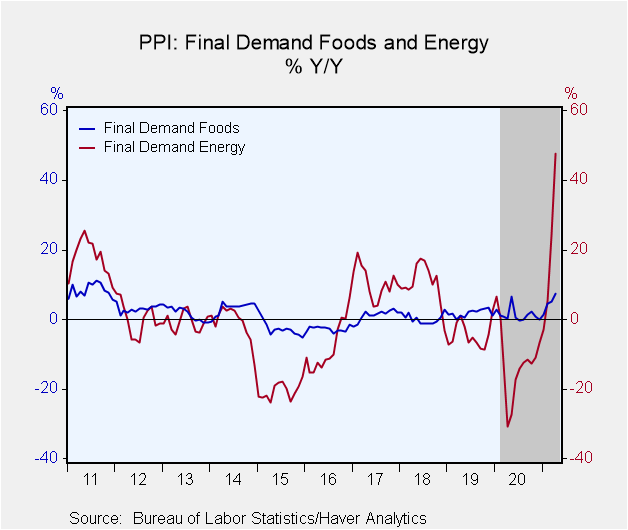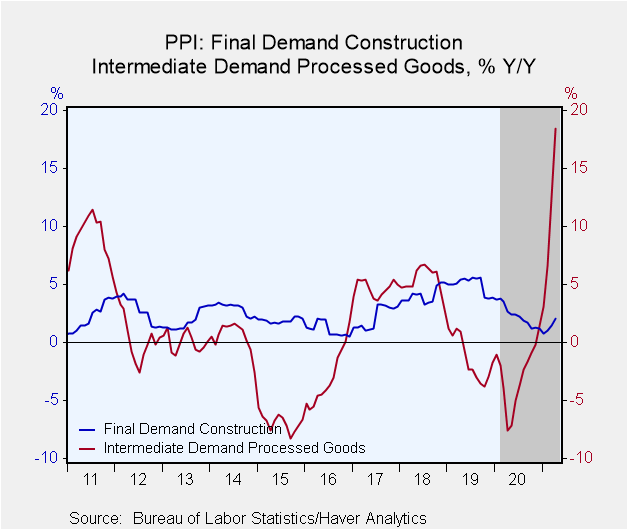 Global| May 13 2020
Global| May 13 2020U.S. PPI Surges Versus Last Year
by:Tom Moeller
|in:Economy in Brief
Summary
• Gain in core finished goods PPI picks up. • Energy prices decline. • Service price inflation eases. The Producer Price Index for final demand increased 0.6% (6.2% y/y) during April following a 1.0% March gain. The index has risen at [...]
• Gain in core finished goods PPI picks up.
• Energy prices decline.
• Service price inflation eases.
The Producer Price Index for final demand increased 0.6% (6.2% y/y) during April following a 1.0% March gain. The index has risen at an 8.5% annual rate during the last three months. A 0.3% rise had been expected in the Action Economics Forecast Survey. The PPI excluding food & energy strengthened 0.7% (4.1% y/y) for a second straight month. The index rose at an 6.1% annual rate during the last three months. A 0.4% rise had been expected. The PPI less food, energy & trade services rose 0.7% (4.6% y/y) after increasing 0.6% in March. The PPI data series dates back to November 2009.
Food prices increased 2.1% last month (7.5% y/y) after gaining 0.5% in March. Beef & veal costs surged 13.4% (14.2% y/y and pork prices strengthened 10.2% (25.6% y/y). Dairy product prices rose 3.6% (6.5% y/y). To the downside, vegetable prices fell 8.5% (-17.1% y/y) and egg prices decreased 29.1% (NSA, -41.9% y/y).
Energy prices declined 2.4% (+47.7% y/y) following five straight months of strong increase. Gasoline prices fell 3.4% (+225.7% y/y) while the costs of home heating oil held steady, but have doubled y/y. The cost of natural gas rose 4.7% ( 12.7% y/y) but electric power prices fell 2.0% (+2.1% y/y).
The 0.7% strengthening in the core PPI reflected a 1.0% surge in goods prices last month, up from 0.9% in March. Private capital equipment prices strengthened 0.6% (2.0% y/y) after edging 0.1% higher in March. Higher prices for core government goods prices again were strong with a 0.8% gain (3.7% y/y). Core consumer goods prices rose 0.6% (2.5% y/y) following a 0.5% rise. The cost of durable consumer goods prices strengthened 0.8% (3.0% y/y), the largest increase since October 2008. Core nondurable consumer goods increased 0.5% (2.2% y/y) for a second straight month.
Services prices increased 0.6% last month following a 0.7% rise. Trade services rose 0.5% after strengthening 1.0% in March. The price of transportation & warehousing of finished goods for final demand rose 0.5% (7.7% y/y) following a 1.6% rise. Services prices less these categories increased 0.5% (4.4% y/y) after gaining 0.4%.
Construction costs strengthened 1.1% (2.1% y/y) following a 0.5% rise.
Intermediate goods prices jumped 1.6% in April (18.4% y/y) following a 4.0% rise.
The PPI data are published by the Bureau of Labor Statistics and can be found in Haver's USECON database. Further detail is contained in PPI and PPIR. The expectations figures are available in the AS1REPNA database.
U.S. Economic Outlook and Monetary Policy from Fed Vice Chair Richard H. Clarida is available here.
| Producer Price Index (SA, %) | Apr | Mar | Feb | Apr Y/Y | 2020 | 2019 | 2018 |
|---|---|---|---|---|---|---|---|
| Final Demand | 0.6 | 1.0 | 0.5 | 6.2 | 0.2 | 1.7 | 2.9 |
| Excluding Food & Energy | 0.7 | 0.7 | 0.2 | 4.1 | 0.9 | 2.1 | 2.6 |
| Excluding Food, Energy & Trade Services | 0.7 | 0.6 | 0.2 | 4.6 | 0.7 | 2.0 | 2.8 |
| Goods | 0.6 | 1.7 | 1.4 | 10.7 | -1.4 | 0.4 | 3.4 |
| Foods | 2.1 | 0.5 | 1.3 | 7.5 | 1.4 | 1.9 | 0.2 |
| Energy | -2.4 | 5.9 | 6.0 | 47.7 | -12.9 | -4.6 | 10.2 |
| Goods Excluding Food & Energy | 1.0 | 0.9 | 0.3 | 4.7 | 0.7 | 1.4 | 2.5 |
| Services | 0.6 | 0.7 | 0.1 | 4.0 | 0.9 | 2.3 | 2.6 |
| Trade Services | 0.5 | 1.0 | 0.1 | 2.7 | 1.7 | 2.4 | 1.8 |
| Construction | 1.1 | 0.5 | 0.3 | 2.1 | 2.3 | 5.0 | 4.1 |
| Intermediate Demand - Processed Goods | 1.6 | 4.0 | 2.7 | 18.4 | -2.8 | -1.4 | 5.3 |
Tom Moeller
AuthorMore in Author Profile »Prior to joining Haver Analytics in 2000, Mr. Moeller worked as the Economist at Chancellor Capital Management from 1985 to 1999. There, he developed comprehensive economic forecasts and interpreted economic data for equity and fixed income portfolio managers. Also at Chancellor, Mr. Moeller worked as an equity analyst and was responsible for researching and rating companies in the economically sensitive automobile and housing industries for investment in Chancellor’s equity portfolio. Prior to joining Chancellor, Mr. Moeller was an Economist at Citibank from 1979 to 1984. He also analyzed pricing behavior in the metals industry for the Council on Wage and Price Stability in Washington, D.C. In 1999, Mr. Moeller received the award for most accurate forecast from the Forecasters' Club of New York. From 1990 to 1992 he was President of the New York Association for Business Economists. Mr. Moeller earned an M.B.A. in Finance from Fordham University, where he graduated in 1987. He holds a Bachelor of Arts in Economics from George Washington University.










